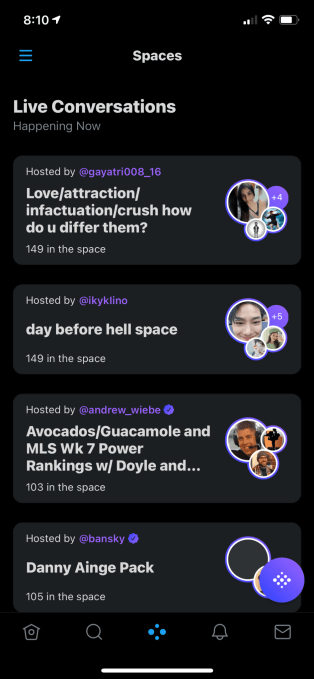APPS
Twitter redesigns its mobile app to make Spaces the center tab

Twitter is updating its app to make its audio chat room feature, Twitter Spaces, a central part of the user experience. Today, the company will begin to roll out to select users a dedicated tab for Twitter Spaces in the main navigation bar of its mobile app, initially on iOS. The feature will see Twitter Spaces gain the middle spot in this bar, in between the Search magnifying glass icon and the bell icon for Notifications. As Spaces is not replacing any other tab, that means the navigation bar will now have to accommodate five icons instead of only four.
Not everyone will see the update immediately. Instead, only around 500 people from the original Spaces beta test will first see the new Spaces discovery tab, as it’s called, when it rolls out today.
Twitter says the tab will showcase the Spaces being hosted by people you follow, but these won’t appear like they do on the Fleet line today at the top of the Timeline. Instead, the discovery tab will present Spaces in a more visual format, similar to the promotion cards that appear when you tweet about upcoming Spaces.

Image Credits: Twitter
The company told TechCrunch that, even though Spaces can be fun, it understands the live events have been hard to find and keep track of, given there’s been no dedicated place where Spaces can be discovered. The new tab aims to change that.
Within the tab, users will be able to see active Spaces with more details, including Space names, hosts and people you know who are participating. The tab will also allow users to manage reminders for scheduled Spaces so you’ll be notified when they’re about to begin, and give Twitter feedback about which Spaces you’d like to see more of.
App researcher Jane Manchun Wong had uncovered Twitter’s plans to revamp its app to include Spaces on the nav bar last month.
Currently, only Twitter users with at least 600 followers have been granted the ability to host Spaces, and Twitter told us that figure has not changed with the launch of the tab. However, the company still has grand plans for the Spaces product, including not only scheduled Spaces which are now becoming easier to find with this discovery feature, but also things like ticketed events, co-hosted events, accessibility improvements and more.
Putting Spaces directly in the navigation bar represents a big push for Twitter’s audio chat rooms, which have otherwise been fairly easy to ignore by those who aren’t that interested in Twitter’s Clubhouse competitor. It also arrives at a time when Clubhouse is expanding access to its own social audio app. Following its debut on Android, Clubhouse said 2 million Android users have already joined its platform.
Twitter, meanwhile, hasn’t yet publicized how many users have tested out Spaces at this point, either as a host or an end user.
Alongside today’s launch, Twitter will also begin to roll out another Spaces feature that was previously being tested: displaying the purple ring around someone’s profile pictures from the Home Timeline.
Currently, profile pics can be highlighted with a blue ring that takes you to the user’s Fleets when tapped, but the new purple ring will indicate they’re actively using Spaces at that time. You can then tap their profile pic to join them. The feature makes it easier to find Spaces while you’re just scrolling your Twitter Timeline as usual.
After the new Spaces tab is tried out with the original beta test group, it will begin rolling out more people, Twitter says.

















